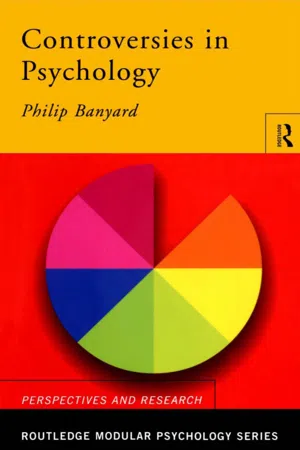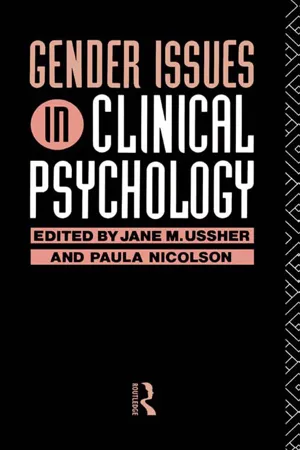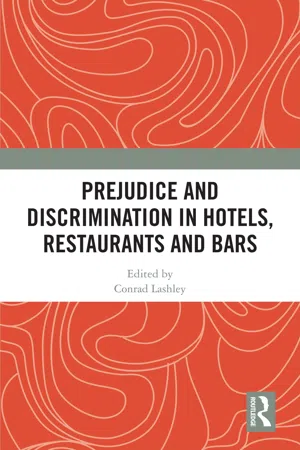Psychology
Gender Bias
Gender bias refers to the unequal treatment or representation of individuals based on their gender. In psychology, it can manifest in research, diagnosis, and treatment, leading to stereotypes and discrimination. Addressing gender bias is crucial for ensuring fair and accurate understanding of human behavior and mental processes.
Written by Perlego with AI-assistance
Related key terms
Related key terms
1 of 4
Related key terms
1 of 3
8 Key excerpts on "Gender Bias"
- eBook - ePub
- Ian Fairholm(Author)
- 2012(Publication Date)
- Bloomsbury Academic(Publisher)
In addition, whilst some psychologists argue that gender ‘is what culture makes out of the “raw material” of biological sex’ (Crawford & Unger, 1995, p. 39), gender is also commonly just used as a synonym for biological sex, which makes things rather more confusing. However, for the purposes of this chapter the word gender will primarily be used to describe the way that males and females are characterised psychologically rather than biologically.Having defined gender, what then is meant by Gender Bias? It can refer to many things but predominantly in this chapter we’ll be focusing on the idea that although psychology has long sought to understand gender – to identify the differences between males and females in terms of their psychology, exactly what those differences are, and to measure how considerable they are – it may have made a fundamental mistake. That mistake is that psychologists have commonly failed to recognise that their own discipline may be fundamentally biased.Feminist psychology, which focuses very specifically on trying to understand gender both within psychology and outside in the wider world, broadly argues that throughout much of its history the discipline of psychology has been dominated by males and has been carried out from a largely ‘male perspective’. Such dominance and perspective is argued to inevitably direct research and theory in some directions at the expense of others, and may potentially reinforce or even seek to justify existing inequalities in the name of science.It’s important to stress that feminist psychology is not a straightforward category either – there are different forms of feminist psychology and not all feminist psychologists think or argue exactly the same things. But what nearly all feminist psychologists can be said to have in common is that they are interested in the concept of gender and how women are affected by it.Similarly, Gender Bias is not a straightforward term either. In fact sometimes Gender Bias is argued to take one of two different forms,alpha biasandbeta bias - eBook - ePub
AQA Psychology A Level Paper Three: Issues and Debates
Issues and Debates
- Phil Gorman(Author)
- 2020(Publication Date)
- Routledge(Publisher)
Chapter 2 Gender BiasSpec check
Gender and culture in psychology – universality and bias. Gender Bias including androcentrism and alpha bias and beta bias.AO1 (Knowledge and understanding): Gender issues in psychology. Does gender play a role in psychological research?
Psychology has, historically, been dominated by men. In attempting to construct a timeline of psychology with my students recently, I found myself falling into this same gender trap. Our first version (guided by me) featured only men. Almost without thinking, I accepted the view that the major branches had all been developed by men and that it was perfectly reasonable to have no women on this timeline (the second version included a number of women).SuchGender Biashas been pervasive in scientific research for centuries and this has included psychological research, and maybe still does. This bias towards the focus on male researchers is, though, just one part of the issue of Gender Bias and, whilst this in itself may cause problems for the representation of women in psychological research, there is a bigger problem that lies beneath the assumptions made by psychological researchers.Whilst it is a problem if all of the people conducting psychological research are men, it is an even bigger problem if this leads to the conclusion that it doesn’t matter as men and women are all the same and therefore we can generalise from the study of men to the rest of the population regardless of gender.Universality and bias
This brings us to the question of whether it’s possible to assume that research carried out on humans can be generalised, regardless of the perceived differences between us. Indeed, in the past and to some extent still today, it has been assumed that we could generalise from the study of animals to human beings and therefore it should be possible to generalise from men to women. Unfortunately, such assumptions have led to some fairly devastating consequences in the field of medical research (thalidomide,DES - eBook - ePub
Sexual Harassment
Psychiatric Assessment in Employment Litigation
- Liza H. Gold(Author)
- 2008(Publication Date)
- American Psychiatric Association Publishing(Publisher)
The continuing influence of gender constructs in psychiatry, the law, and forensic psychiatry can create profound and hidden bias in forensic assessments. Gender Biases in forensic psychiatry are derived from the biases of psychiatry and the law. These professional disciplines, like all others, have incorporated many of the long-standing male-oriented Gender Biases of Western culture (Baer 1999; Frederick and Atkinson 1997; Hoff 1991; Rhode 1989; Rosenberg 1997; Sherwin 1992; Showalter 1985; Tomes 1994). Psychiatric training and evaluation techniques provide the conceptual framework and methodology for forensic psychiatric assessments. Legal theory and practice frame the questions that are asked and dictate many of the procedures and rules governing how psychiatrists can answer these questions. The way a question is framed substantially influences the perspective from which it is addressed (Rhode 1999).Identifying Gender Bias
Analysis of gender constructs in any discipline is intended to to determine whether apparently neutral theory and practice in fact create advantage or disadvantage for one gender or the other. Certain identifiable processes result in the creation and perpetuation of the hidden gender assumptions and bias in disciplines such as psychiatry and the law.The dominant group in any culture inevitably defines its own attributes as normal and desirable. In a male-dominated culture, men’s experiences and traits define the norms of experience, personality, ideals, and behavior. This results in standards of evaluation and comparison involving “universal” normality that appear gender neutral but are actually androcentric and male biased. Thus, theory and practice created by men contain an inherent but invisible male bias across disciplines.In addition, the experiences of other groups that are not shared by men are often not defined or recognized. Language or conceptual framework for the definition or discussion of such experiences does not exist. As a result, women’s experiences often become invisible and easily ignored, creating another, subtle form of Gender Bias (Baer 1999; Frederick and Atkinson 1997; Hoff 1991; Paludi 1998; Rhode 1989, 1999; Tomes 1994; Unger and Crawford 1996).Specific Gender Biases in psychiatry and law related to these processes have been extensively discussed. Freudian theory, the dominant school of psychiatric practice during the past century, contains many obvious examples of such biases (Miller 1984; Miller and Stiver 1997; Stone 1984; Tomes 1994; Unger and Crawford 1996). Much of Freud’s theory incorporated and reinforced the gendered beliefs of prevailing medical theory and the cultural traditions of the late nineteenth century. Psychoanalytic developmental theory demonstrates the process of the creation of Gender Bias by basing “human” theory on male assumptions, values, and experiences. Subsequent developmental theory also reflects male Gender Biases derived from stereotypes and the universalization of male standards of normality (Gilligan 1993; Jordan 1997; Jordan et al. 1991; Miller 1984; Miller and Stiver 1997). - eBook - ePub
- Phil Banyard(Author)
- 2003(Publication Date)
- Routledge(Publisher)
4 Bias in psychology
Introduction
It is interesting that we have a title such as ‘bias in psychology’. It seems obvious to me that everything in psychology contains some sort of bias or other, but what is remarkable is that this bias is often not acknowledged. Perhaps this is because one feature of the scientific approach in psychology is the attempt to be objective. To be objective is usually taken to mean standing apart from the subject that is being studied, and being free from bias. This might be possible if we are studying chemicals or micro-organisms, but is it possible to be objective when we are studying the behaviour and experience of people? It is difficult, if not impossible, to stand apart from the subject that is being studied when the subject is human behaviour and experience and you are a human being. In this chapter we will look at some examples of bias in psychology, and pay particular attention to issues around cultural diversity and gender. We will start by looking at the concept of ethnocentrism.Ethnocentrism
One source of bias in psychology comes from the fact that we tend to see things from our own viewpoint and the viewpoint of people like us. In our everyday lives we are asked to make judgments about people and events. We have a range of opinions that we are prepared to offer to other people when asked, and sometimes when not asked. In our judgments we are often inclined to show a little egocentrism (seeing things from our own particular viewpoint to the exclusion of others). Another bias that can affect our judgments is ethnocentrism - eBook - ePub
- Paula Nicolson, Jane Ussher(Authors)
- 2006(Publication Date)
- Routledge(Publisher)
Table 1.3 ). Further, the staff/trainers on professional courses reflect a gender imbalance in favour of men as the trainers with women as trainees — corresponding with the female-male ratio in academic psychology overall (Kagan and Lewis 1990b).In order to understand and explain why the gender imbalance in favour of males is sustained, it is necessary to look beyond openly sexist challenges such as that of Crawford (1989). They are but the tip of the iceberg leading investigations as to why women's opportunities are curtailed up a blind ally! It is not these open expressions of ‘gender war’ but the covert discriminatory practices that occur everyday at all levels of the profession that produce inequalities. That they are often so embedded in social norms that they occur without most people being aware of them as sexism is part of the fabric of western applied and academic psychology.The notable absence of gender as an issue in the two influential UK reports on clinical psychology (MAS 1989; MPAG 1990) provide indices of this sexism. The very exclusion of gender discussion when there is quite clearly a balance of power in favour of men is an effective means of making women invisible.The debate about how far explicit inclusion of gender is problematic for women is an intriguing one. It is the uncontested view of the authors of all the chapters in this book that ignoring gender in any context where there are clear issues of power imbalance is equivalent to enabling men to maintain the balance in their favour. The rhetoric employed to prevent feminist scrutiny (as opposed to the sexist assertions about gender balance quoted above) penetrate both female and male consciousness so that women achieving success are often the fiercest advocates of ‘gender neutrality’. That is, they favour gender blindness over explicit equal opportunities. But exactly who operates gender blindness? When men's backs are to the wall, as when ‘too many’ women are perceived to be entering the discipline, gender is raised as a topic for discussion by men to disadvantage women. Gender neutrality as a strategy, covertly operates to the advantage of men and only men. Evidence and examples presented below will justify this assertion. - Conrad Lashley(Author)
- 2022(Publication Date)
- Routledge(Publisher)
2021 ) makes the distinction, ‘… bias’ conveys a leaning towards or preference for something,’ (2021:2) … ‘whereas prejudice conveys a pre-judgement without knowledge or examination of the facts’ (p. 3).Bias is seen by psychologists as a tendency to think about other people, social groups, the world, and personal actions in a consistent way, for example, perceiving human actions as essentially individualistic and selfish; or essentially collective and generous. Bias will tend to assess personal successes and failures in ways that favour the individual’s self-image. Successes are attributed to personal talents and skills, whilst failures are usually explained as the fault of other people, bad luck, or circumstances beyond the individual’s control. ‘Within psychology “bias” is often used to denote a tendency – usually unconscious – to think in a particular way, for example the causes of people’s behaviour’ (Gross, 2021 :5).Self-enhancing bias involves individuals justifying positive achievements as being due to their personal efforts – hard work – intelligence, etc. Kruger and Dunning (1999 ), two US psychologists, report a tendency amongst the lowest achievers to over-assess their performance in tests. In another piece of research, the same research team found that those with the lowest IQ scores tended to over-assess their IQ scores. In the play, As You Like It, William Shakespeare makes a similar point with the line that starts, ‘The fool thinks himself to be a wiseman…’. Going even further back in time the Greek philosopher, Socrates, concluded that ‘…. stupid people have all the answers’. The tendency to self-enhancement bias will often over-play these due to a self-serving bias that aims to address and enhance the individual’s esteem needs. Abraham Maslow created a hierarchy of human needs in his famous motivation theory, where esteem needs are classified as higher order needs- eBook - ePub
- Richard Gross(Author)
- 2023(Publication Date)
- Routledge(Publisher)
1989 ), definitions of Feminist Psychology (FP) vary widely, in both substance and inclusiveness. For example, in the US, ‘FP’ and the ‘Psychology of Women’ are often used synonymously: psychological research on women, and the researchers, are automatically described as ‘feminist’. But in the UK, these areas are generally more clearly distinguished.This chapter explores some of the major criticisms of mainstream Psychology that have been made from a feminist perspective. These include:- A great deal of psychological research is conducted on all-male samples, but then either fails to make this clear or reports the findings as if they applied equally to women and men.
- Some of the most influential theories within Psychology as a whole are based on studies of males only but are meant to apply to women and men equally.
- If women’s behaviour differs from men’s, the former is often judged to be abnormal or deviant or deficient in some way: men’s behaviour, implicitly or explicitly, is taken to be the norm or ‘standard’ against which women’s behaviour is evaluated.
- Psychological explanations of behaviour tend to emphasize biological – and other internal – causes, as opposed to social – and other external – causes, thereby giving (and reinforcing) the impression that psychological sex differences are inevitable and unchangeable. At the same time, this reinforces widely-held male and female stereotypes. As well as being inherently objectionable, such stereotypes contribute to women’s oppression.
- Heterosexuality – in both women and men – is taken (implicitly or explicitly) as the norm: homosexuality – by definition – is abnormal.
According to Davis and Gergen (1997 ):However, a major barrier to achieving these goals is Psychology itself:The basic commitment of feminist psychologists from many backgrounds has been to overcome the commonplace stereotypes of gender differences, and to eradicate the biases that suppress women in society.(p. 2)Feminist Psychology attempts to harness the power of psychology to improve the status of women. But in order to be able to use psychology to bring about change in the wider world, feminist psychologists believe they must also bring about changes in psychology. This is because…traditional psychology still reflects many of the Gender Biases of the larger society, albeit in subtle and implicit ways…feminist psychology is explicitly political and nourished by the feminist movement. - eBook - ePub
- Vivien Burr(Author)
- 2002(Publication Date)
- Routledge(Publisher)
Chapter 6
Gender and psychological research
How has gender been researched by psychologists?
Sex differences
Psychology’s approach to the study of gender has, not surprisingly, been to regard gender as an intra-psychic phenomenon. That is, gender, like many other phenomena of human experience, has been thought of as part of a person’s psychological make-up, like other aspects of their personality such as extraversion or self-esteem. Of course our experience of gender is a profoundly psychological one, but the important social and political aspects of gender have largely been ignored by psychologists and much of the research in this field therefore reflects this bias. This strong tendency to see gender as (no more than) an interesting personality trait has resulted in a great deal of research which documents a range of differences between women and men but has little that is useful to say about how these findings may be interpreted.There has been a strong focus upon sex differences research in psychology (see Chapter 2 ), particularly in the 1960s and 1970s. This interest was partly driven by the growing popularity of psychometrics in psychology, but there also appears to be an underlying assumption, first, that women and men are psychologically quite different from each other, and second that these differences are of importance for our understanding of human behaviour and experience. This manifests itself in a tendency to build sex comparisons into research designs almost automatically, and, as I pointed out in Chapter 2, to over-report findings of significant difference and to under-report findings of similarity, despite the fact that significant differences may be numerically small.Masculinity and femininity
Apart from sex differences research, a second popular area of concern for psychologists has been the measurement of masculinity and femininity. Numerous scales and inventories designed to measure these were devised in the first half of this century, and, as might be expected, their designers often did not critically examine the assumptions upon which such scales were built. Constantinople (1973) provided one of the first critical reviews of such tests and, in her critique of these assumptions, paved the way for the emergence of the concept of ‘psychological androgyny’ (Bem, 1974; see below).
Index pages curate the most relevant extracts from our library of academic textbooks. They’ve been created using an in-house natural language model (NLM), each adding context and meaning to key research topics.
Explore more topic indexes
Explore more topic indexes
1 of 6
Explore more topic indexes
1 of 4







